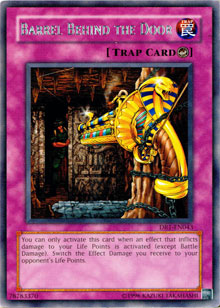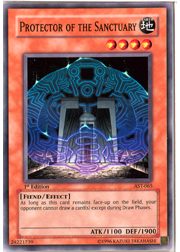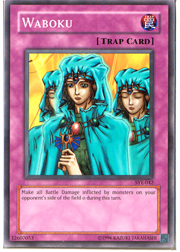
Have you learned new and exciting things about chaining over the past few weeks? Have you thought up moves you hadn’t dreamed of before? Have you avoided making embarrassing misplays at your events? I hope that at the very least, you have found these articles interesting. Today’s topic may be rather narrow, but it trips up many a player. Specifically, we’re going to look at chaining to your own effects.
Up until now, we’ve treated chaining as a “you do this, your opponent responds with that, you add on yet another effect,” sort of process. That’s the usual way it goes down—going back and forth between opponents—but chaining doesn’t always involve both players. One player can string together a series of effects all by him- or herself if the opponent doesn’t wish to activate any intermediate effects. As long as you have another effect that’s valid to activate, and your opponent has declined to respond to your previous link, you can chain to your own effects.
Bear in mind that “chaining to your own effects” does not mean “activate cards quickly one right after the other before your opponent has a chance to get an effect in edgewise.” The point is not to go faster than your opponent. If you want to chain to your own effect, ask your opponent if he or she wishes to respond (or at least, pause for several seconds so your opponent can speak up). The clearest way to avoid a scene is to ask. If you don’t want to tip off your opponent that you’re planning on chaining to your own card, you can make a habit of asking, “Any response?” whether you’re planning on activating anything else or not. Don’t waste time with the process, but make sure you’re both clear on who wants to do what and when.
All right, so you can chain to your own effects. Excellent! Now, why would you want to? There are actually plenty of good reasons, depending upon the particular scenario. Here are a few of the most commonly seen reasons.
To Create Your Own Activating Triggers
 Sometimes you don’t want to wait around for your opponent to oblige you with an activating trigger. Other times you’d be best served by stringing together some complementary effects. The best-known example here would probably be the good old Barrel Behind the Door chained to your own Ring of Destruction. It’s a fun one. Your opponent summons something really, really big and you respond with Ring of Destruction. He or she isn’t happy, but figures you’re going to bite the bullet—then bang! You play Barrel Behind the Door. That’s a double dose of damage for your opponent (and goodbye to the monster) while you sit there grinning.
Sometimes you don’t want to wait around for your opponent to oblige you with an activating trigger. Other times you’d be best served by stringing together some complementary effects. The best-known example here would probably be the good old Barrel Behind the Door chained to your own Ring of Destruction. It’s a fun one. Your opponent summons something really, really big and you respond with Ring of Destruction. He or she isn’t happy, but figures you’re going to bite the bullet—then bang! You play Barrel Behind the Door. That’s a double dose of damage for your opponent (and goodbye to the monster) while you sit there grinning.
As long as we’re here (and plenty of players never realized this when these cards were being played), putting anything in between a trap and a counter trap will break the chain. A counter trap, like Barrel Behind the Door, has to be activated directly after the card it intends to affect (which in this case is Ring of Destruction). Putting anything else in between, even if it’s not relevant to the first link (such as Mystical Space Typhoon) will prevent the counter trap from activating. Keep that in mind when your opponent asks, “Any response?” after activating a trap card.
To Protect a Special Summon Effect
Ever play Return from the Different Dimension? Let’s see, you have, and you have, and that other guy has too! And if you haven’t, you’ve used Call of the Haunted, right? What do all of you hate? You hate bringing all those monsters to the field, only to lose them to Torrential Tribute or Bottomless Trap Hole, right? Sure you do. Did you know that you can avoid that with a simple chaining trick?
Here’s the deal. Your opponent can only activate one of those cards when the last thing to happen was the summoning of a monster, right? Right! So take a moment to think this over. What can you do to prevent the last thing that happened in the game from being a special summon? You can chain the special summon effect to something else! How about Smashing Ground? Or your Nobleman of Crossout? First, activate an effect—just about any effect will do, as long as it doesn’t result in a summon—and then chain your Return or Call. (Of course, your opponent has a chance to respond in between. This is very important, so don’t forget it.) Your summoning effect will resolve first, followed by the first effect you activated—which will be the last thing to happen, and therefore blocks Torrential Tribute or Bottomless Trap Hole. Oh, you are sneaky.
To Construct a Chain that Achieves The Impossible
There are some combos that would be just plain fantastic, if it weren’t for the fact that someone realized they were totally unfair and provided a ruling to stop them. But through the miracle of chaining to your own effects, you can sometimes do things you wouldn’t otherwise be able to do. Here’s a good one, especially if your opponent is a maniac for holding onto his or her cards. I guarantee that you can find at least one at any event, and he or she isn’t going to like this at all. Make sure you do this in the correct order, or it won’t work.
 First, set Protector of the Sanctuary. Then, activate Disturbance Strategy. Check to see if your opponent has a response. If he or she doesn’t, chain Ceasefire. (Desert Sunlight will work too, but I like Ceasefire better.) Do you know what happens now? Provided no one adds any more links to the chain, it resolves backwards. Protector of the Sanctuary flips face up and your opponent takes at least 500 damage from Ceasefire, then Disturbance Strategy forces him or her to discard his or her entire hand. Due to Protector’s effect, your opponent cannot draw a replacement hand. Isn’t that just too bad? Especially if that opponent’s been hugging those cards like a monkey with the last bunch of bananas for the past five turns.
First, set Protector of the Sanctuary. Then, activate Disturbance Strategy. Check to see if your opponent has a response. If he or she doesn’t, chain Ceasefire. (Desert Sunlight will work too, but I like Ceasefire better.) Do you know what happens now? Provided no one adds any more links to the chain, it resolves backwards. Protector of the Sanctuary flips face up and your opponent takes at least 500 damage from Ceasefire, then Disturbance Strategy forces him or her to discard his or her entire hand. Due to Protector’s effect, your opponent cannot draw a replacement hand. Isn’t that just too bad? Especially if that opponent’s been hugging those cards like a monkey with the last bunch of bananas for the past five turns.
Ordinarily you wouldn’t be able to activate Disturbance Strategy if you had a face-up Protector of the Sanctuary, but by setting up a neat little Rube Goldberg-esque chain, you can legally pull off the combo. If you want to build a deck around a trick like this, it’s a good idea to check with a judge first to make sure it will work the way that you want it to. Round 2 is a terrible time to find out that it won’t.
To Save Cards From Your Own Effects
Sometimes you’ll want to activate an effect that could hurt you as well as your opponent. In instances like these, the ability to chain to your own cards can keep whatever it is from being too terribly painful, or even turn it into an advantage. A common example is to chain your own set cards to your own Heavy Storm—most often something like Call of the Haunted to bring back Jinzo or Sangan, or Scapegoat to fill up your field. It can be a good bluff, since your opponent is less likely to suspect you of an impending Heavy Storm if you’ve got a card or two of your own set.
To Save Cards From Your Opponent
 You can do the same kind of thing if your opponent activates a potentially devastating effect. Suppose he or she summons Mobius the Frost Monarch, or the aforementioned Heavy Storm. If you’ve got a string of set cards with spell speed 2 or higher, you can start hooking them onto the chain as long as there’s a valid reason to activate them. Chain Waboku to Jar of Greed, or Call of the Haunted to Ceasefire. Chain all four of them if you want to! However, make sure that anything you chain has met its activation requirements. If the trigger isn’t there, you’ll just have to bid it adieu. (No chaining Scapegoat, then Torrential Tribute, to Heavy Storm.)
You can do the same kind of thing if your opponent activates a potentially devastating effect. Suppose he or she summons Mobius the Frost Monarch, or the aforementioned Heavy Storm. If you’ve got a string of set cards with spell speed 2 or higher, you can start hooking them onto the chain as long as there’s a valid reason to activate them. Chain Waboku to Jar of Greed, or Call of the Haunted to Ceasefire. Chain all four of them if you want to! However, make sure that anything you chain has met its activation requirements. If the trigger isn’t there, you’ll just have to bid it adieu. (No chaining Scapegoat, then Torrential Tribute, to Heavy Storm.)
Anyway, if you couldn’t chain to your own effects, you’d be reduced to the sorry state of deciding which of your set cards you love best, while the rest tumble into the graveyard. But because you can, not only do you avoid that unpleasantness, but you can give your opponent a nasty surprise. If the effect that he or she activated was supposed to put you at a disadvantage, and instead resulted in a “safe zone” (Waboku), an extra card in your hand (Jar), 2000 in direct damage and a worthless Dekoichi (Ceasefire) and your Sangan back on the field, well, that’s not going to make your opponent very happy.
If you want to take advantage of all these chaining effects, then study up on your card rulings to make sure that what you want to do is actually going to work. Review your basic chaining information, to make sure you’re putting everything in the correct order. And always remember, you have to give your opponent a chance to respond! Your combo may be vulnerable if your opponent is able to link to your chain, so always consider that possibility. And don’t just rattle off link after link, assuming that there’s nothing they can do and that your combo is a guaranteed thing. It’s possible that your opponent can’t stop it, but he or she should always have a chance to respond. Don’t get a judge involved just because you went too fast and presumed too much—and gave away your strategy at the same time.
Believe it or not, I’ve got more to say about chaining. Don’t miss out next week, as I dig out yet another under-explored aspect of this rule. Who knew chaining could be so engrossing?